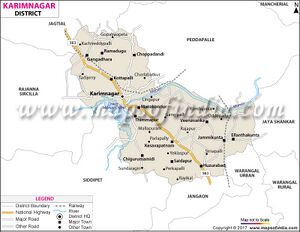Karimnagar
| Author:Laxman Burdak, IFS (R) |


Karimnagar (कारीमनगर) is a city and District in the Indian state of Telangana.
Location
It is situated on the banks of Manair River, which is a tributary of the Godavari River.
Origin
During the Nizam era, the name Karimnagar was named for a village by an Elgandala Qiladar, Syed Karimuddin.
Variants
History
Kotilingala now in Jagtial district was the first capital of the Satavahana Kingdom (230 BCE–220 CE). Formerly known as Sabbinadu, inscriptions dating to the Kakatiya dynasty by kings Prola II and Prataparudra found at Karimnagar and Srisailam provide evidence of the area's rich history.[1]
Archaeological excavations in Pedda Bonkur, Dhulikatta and Kotilingalu show that the area was once ruled by the Satvahanas, Mauryas and Asaf Jahis.[2]
History of Karimnagar district
Following content is from ....History And Legend In Hyderabad, Department of Information and Public Relations, 1953, p.73-74-75
Karimnagar is a little obscure, though there are traces which represent a people lost to history but who may have flourished over 2,500 years ago. At Ellanthakunta local tradition associates the temples of Sri Rama with Sri Ramchandra’s visit to the place while in exile in the Dandakaranya. Where history fails, surely tradition must take its place. Hewitt’s references to Telingana in his Ruling Races of Prehistoric times seem to indicate that this part of the south was by no means unimportant in the ancient world.
The district was formerly known as “ Sarkar Yeligandal ” and in 1905 was renamed as Karimnagar. Most of the district was under the kings of Warangal and portions of the present Mahadeopur taluq were under the Gond rajas.
Malik Kafur, a general of Alauddin Khilji, invaded this country in the year 1309 and defeated Raja Pratap of Warangal and the forts of Elgandal and Malangur fell into Muslim hands. In 1507 these forts passed into the hands of Qutb Shahis along with Warangal. These were later occupied by the Nizam.
Close to the fort of Malangur there are old graves, believed to be those of Jains.
Another fort of interest in the district is the Ramgir fort situated on the top of a hill.
Fort of 400 Temples: The Nagnur fort has considerable historical importance. It derives its name from the fact that there were 400 temples in it at one time. “ Nalgunoorlu,” the Telugu word for four hundred, was corrupted to “ Nagnur.” Even today there are two good temples — one of Vishnu and the other of Siva. There are three stupas or pillars called “Budhatis,” which are believed to have been constructed during Asoka’s time. This shows, that the place is of ancient origin.
The temples of Kaleswar and Dharmapuri on the banks of the Godavari and those at Vemalwada and Ellanthakunta attract large numbers of pilgrims during the annual
[p.74]: jatras. At Kaleswar is one of the Siva temples that mark the extremity of the Trilinga or Telugu country in the north.
The fort at Elgandal, built by Zafaruddaula about 1754, contains a mosque with a minaret which oscillates when shaken.
In Jamikunta are the two forts of Bajgur and Malangur, said to have been built respectively 700 and 1,000 years ago, and the two temples of Gurshal and Katkur.
The former, built about 1229, during the reign of Raja Pratap Rudra of Warangal, though now in ruins has exquisite stone carvings still in a good state of preservation.
A pillar outside the temple has an inscription in Oriya.
The fort of Jagtial was built for Zafaruddaula, in 1747, by French engineers. In the same taluq is the old temple at Dharampuri on the right bank of the Godavari.
The old fort of Anantagiri in the Sirsilla taluq, now in ruins, is built on a hill. Two mosques in the taluq, one at Kaleswar and the other at Sonipet, were built by Aurangzeb, as also was the mosque at Rajgopalpet in the Siddipet taluq, Pratapgiri fort in the Mahadeopur taluq, is said to have been built by Raja Pratap Rudra.
Vemalwada has a temple on the south of a large tank in the enclosure of which is the tomb of Hazrat Beg Sarwar which is regarded as sacred by Hindus and Muslims alike.
In the Karimnagar taluq, Bijikhi has an old sculptured Siva temple the four central columns of whose mandapa are well-carved, while Kotapetta has a temple of the Chalukyan (Kakatiya) period.
Vemalwada has a temple on the south of a large tank in the enclosure of which is the tomb of Hazrat Beg Sarwar which is regarded as sacred by Hindus and Muslims
alike.
In the Karimnagar taluq, Bijikhi has an old sculptured Siva temple the four central columns of whose mandapa are well-carved, while Kotapetta has a temple of the Chalukyan (Kakatiya) period.
Huzurabad: The dargah of Shah Wali at Malangur is held in great esteem by Hindus as well as Muslims, while the hill fort there is said to have been built 1,000 years ago. A 13th-14th century temple at Borapalli has a stone slab with Nandi on top and Kannada inscriptions on either side.
Jagtial: The fort here was built for Zafaruddaula by French engineers and is on the same lines that at Nirmal. There is also a mosque of the period in Jagtial.
Sultanabad: The temple at Kundagal has a beautifully sculptured column carvved in black stone, while the ruined temple consecrated to Siva and Vishnu has a finely sculptured slab inside. Huge blocks of stone have been used in constructing this building.
Manthani (Mahadeopur) in the taluq is regarded as a holy place because Sage
[p.75]: Gautama performed his tapas here. There are several temples here, the largest being the Silesvaragudi which has a sikhara resembling those of south Indian temples. An inscription in old Nagri refers to king Ganapati of Warangal.
Karimnagar has also numerous prehistoric sites scattered all over the district.

